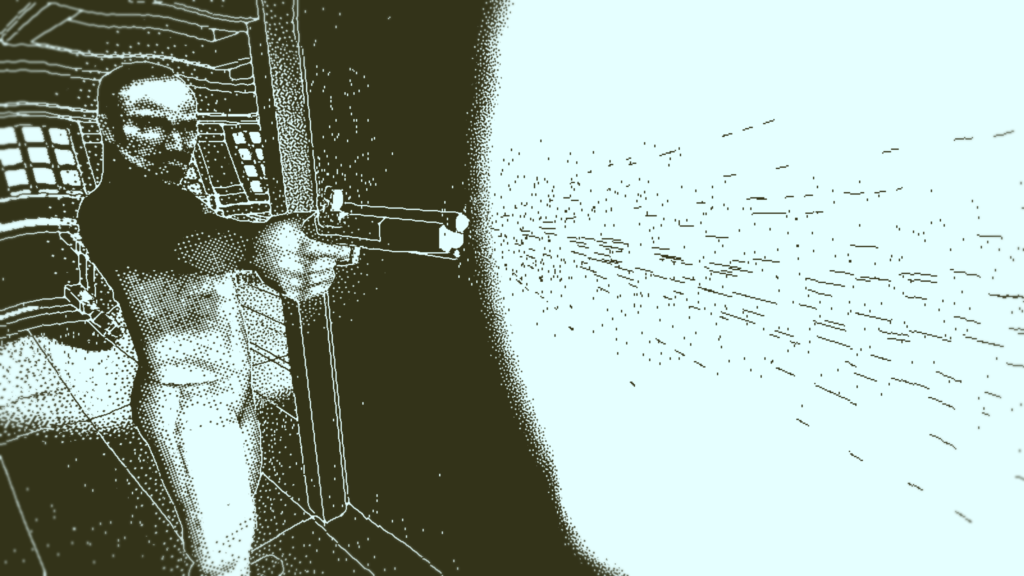I don’t usually play first-person point of view games. I’ve always found them to be restricting, giving me a very incomplete sense of the world around me and the options available to my character. Yet instead of the normal frustration I usually encounter when my character’s vision is limited to a narrow scope, I found the use of first-person perspective in Return of the Obra Dinn to actually enhance my gameplay experience. In this post I’ll examine how the game’s classification in the mystery genre lends itself well to a first-person perspective, and how the game’s point of view enables the reader to more closely interact with the storyline.
Return of the Obra Dinn can be classified as an interactive mystery game. The plot is devoted to uncovering surprising clues and piecing together a complete picture of the initially vague cause of the Obra Dinn’s disappearance. Beyond the plot, however, the first-person perspective of the game also provides justification for the game’s categorization as a mystery. When you play in a first-person perspective, at least half of the screen is obscured at any point. Your character has no knowledge of what is behind them, and you as a player don’t either, unless you turn your character around. This allows the game to create moments like this scene which appears the first time the player uses the pocket watch:

At this moment the player character lacks the context of the whole scene, due to their first-person perspective; this immediately generates multiple questions in the player’s mind, such as “who is this man and why is he shooting me?” These questions present a mystery, piquing the player’s interest and encouraging them to seek answers.
If the game was presented in a third-person POV, the player would likely immediately identify that the man was shooting at another man on the ship. This would probably generate questions as well, and may still serve the same purpose of drawing the player into the game, but it lacks the immersive factor that the first-person point of view provides. The first few minutes of Return of the Obra Dinn feel very detached, in the sense that the player character is investigating a foreign setting involving a bunch of random people with whom they have no personal investment. Yet the transition into this moment, and the limited player perspective, immerses the player themself into the game, as they are suddenly involved in the action of a gun fight. The player’s confusion over their sudden involvement is quickly resolved as they pivot their character’s perspective, but it still draws the player into the game initially, and provides an air of mystery on a more immersive, personal level.
Beyond prompting the player to feel a greater visual level of immersion in the storyline, the first person point of view also directs their focus towards the other characters in the game rather than their own character. As was mentioned in class, the player character is actually quite uninvolved in the story. They’re a third party observer, with no ability to affect the flashbacks as they are nothing more than an investigative observer. Since the only part of the protagonist visible in the game is their gloved hand, holding the pocket watch and interacting with objects becomes the focus of the player’s attention, rather than any physical characteristic of their character. This emphasis of story over player, as well as the increased level of immersion intrinsic to first person point of view games, thus makes the first-person perspective of Return of the Obra Dinn a particularly compelling format in which to play the game.

I agree with everything you’ve said, and I think this perspective fleshes out a feeling I get from Return of the Obra Dinn that’s reminiscent of found footage horror movies- a key element of the game’s intensity comes from what is and isn’t being shown, but unlike a more “3rd-person” mode of showing/not showing, what does or doesn’t make it onscreen is intertwined with the player/central character’s own perspective and decision-making. I think especially in film, we’re so accustomed to the omniscient lens of either “I’m showing you something important” or “what I’m not showing you will build the importance of what I do show you,” that introducing the first-person “incidental” perspective leaves the viewer or player more off-balance as to where the situation’s tension lies- and for me, this destabilization of emphasis heightens the tense experience all the more.
Very good point! On top of the first-person POV being a very engaging one, I also found that the POV allowed for some super compelling visuals. The opening shot of the flashbacks always felt so meticulous manicured to me, and I believe the developer specifically composed them to be shocking and intriguing (‘beautiful’ doesn’t seem correct, given how gruesome many of the scenes were, but the way that they shots were put together and the graphics of the game did create a very aesthetically pleasing image for me). When I entered the first death-flashback, the scene of being shot at by a stranger in front of me felt so cinematographic that I thought I had entered into a cut scene, and I sat back to let the movie play out in front of me. Instead, I had to investigate for myself, closely examining the figures around me and my surroundings. The developer of the game controlling the POV creates flashback opening shots that I absolutely love, causing immediate intrigue, horror, confusion, even shocked, like when a character that had appeared in many other flashbacks suddenly appears in front of me at the moment of their death – even if I had not figured out their identity, they became familiar to me, and their sudden, and often dramatic, passing, had a surprising amount of effect on me.